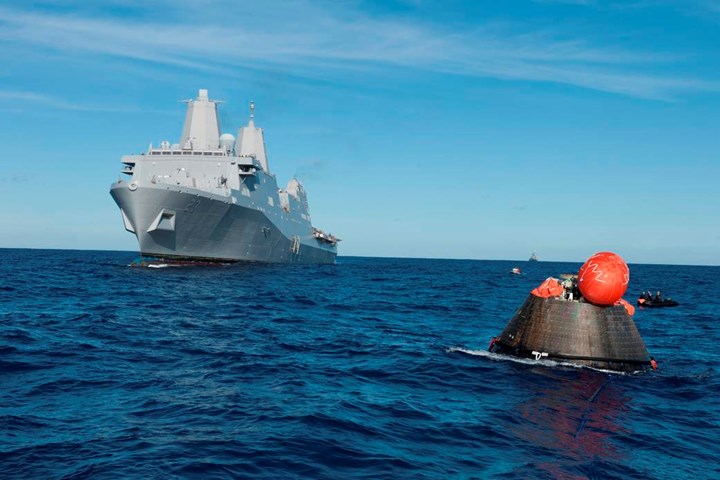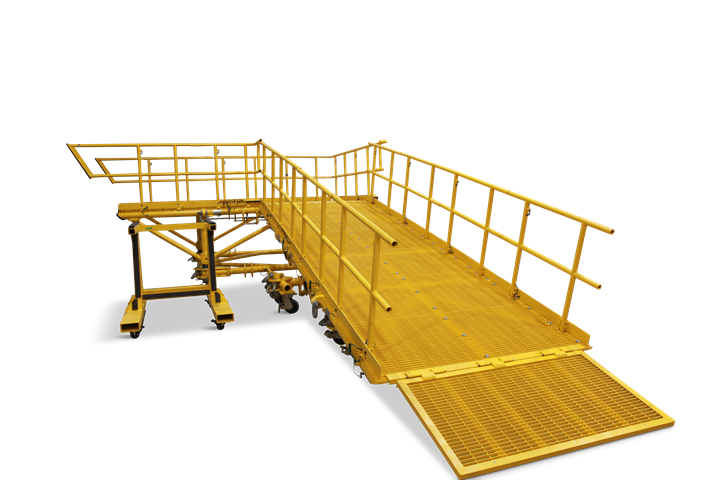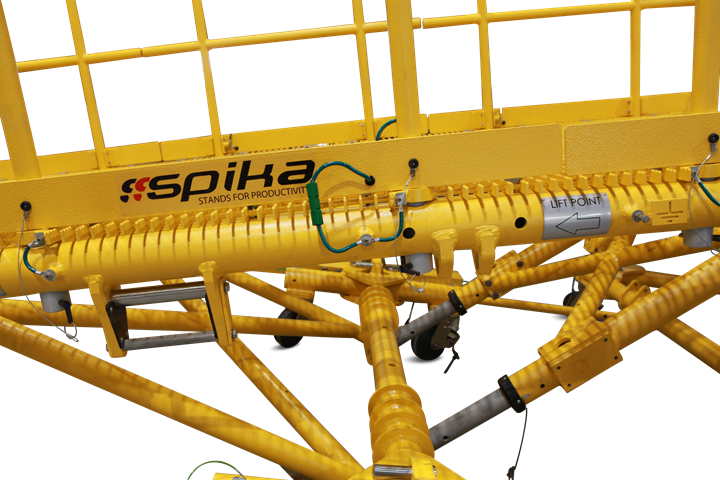
When the Orion capsule returns to Earth, a series of operations and a host of equipment are needed to ensure the safe recovery of the spacecraft and its crew. Photo Credit: U.S. Navy
It’s hard not to get goose bumps when thinking about the advances made in the U.S. space program in just the past few years. In May of 2020, American astronauts were launched into orbit for the first time since the end of the Space Shuttle Program in 2011. The mission also marked the first time such a launch was conducted by a private company. The Falcon 9 rocket and Crew Dragon capsule were built by SpaceX — opening a new chapter of space exploration where private companies are partnering with NASA in new and exciting ways.
From there, it seemed like NASA had one exciting announcement after another. The latest Mars Rover was launched in July of 2020 and safely landed on the red planet in February of 2021. The James Webb Space Telescope, which has been the culmination of decades of development and testing, was safely launched on Christmas Day in 2021 and is now safely in L2 orbit performing final preparations for its service. Landing a robotic rover on a target 34 million miles away. Placing a telescope in space that can yield images 13.6 billion light years away. Thinking of all the accomplishments that are being made and the magnitude of those undertakings is dizzying.
Featured Content
During all this progress, NASA has also been working on its Artemis program — the goal of which is to return humankind to the moon by 2025. The scope of the Artemis program is vast, with plans for a lunar base camp on the moon’s surface and space station in lunar orbit. At the heart of the program will be NASA’s Space Launch System rocket and the Orion spacecraft, used to ferry astronauts between Earth and lunar orbit. But, what of other equipment necessary for the program? There are more than 3,800 suppliers working with NASA prime contractors to support the Artemis program. The amount of engineering work and bespoke manufacturing that each space application requires is nothing short of amazing — and all of that exacting work is what makes space exploration possible.
The work needed to make these missions successful goes well beyond the spacecraft themselves. Take recovery operations, for example. When the Orion capsule returns to Earth and splashes down in the ocean, a series of operations and a host of equipment are needed to ensure the safe recovery of the spacecraft, and more importantly, its crew.

The Artemis Egress Platform is a specialized custom platform and ramp that allows the crew to safely disembark the Orion spacecraft within the well deck of the landing platform dock ship. Photo credit: Spika Design & Manufacturing
Getting astronauts home
As we look to the future, we build upon the successes of the past. Upon splashdown, the method for retrieving the Orion spacecraft is essentially the same as with the Apollo missions of the late 1960s and early ‘70s. The recovery mission involves a highly trained crew of divers and technicians who retrieve the capsule from the ocean using small rigid hull inflatable boats to tow it back to a San Antonio Class vessel outfitted with a specialized platform and ramp that allows the crew to safely disembark.
Like many workhorse aspects of the space program, the Artemis Egress Platform is much more than meets the eye. The platform requirements include the ability to be stored in a low configuration in the belly of the ship. It must be light enough to be moved quickly. It also must stand up to a challenging environment.
NASA Artemis I recovery director, Melissa Jones, described the recovery process in a recent episode of “Houston We Have a Podcast,” the official podcast of the NASA Johnson Space Center. “We use a Navy landing platform dock ship (LPD), and it basically has a well deck [that] floods with about seven feet of water,” Jones explains. “We attach lines to the capsule from the ship using the small boats … we use a winch in the well deck to bring the capsule in and set it down on a cradle. Then the ship pumps all the water out of the well deck.”
To meet all the mission requirements and to stand up to the ocean exposure presented by the open well deck, Jacobs Technology Inc., which operates the Kennedy Space Center for NASA, turned to Spika Design & Manufacturing (Lewistown, Mont.), an equipment manufacturer specializing in custom work platforms for a variety of industries including aviation and automotive.
Jeff Ruffner, P.E., director of business development for Spika, describes the company’s custom solutions as “extremely high-end work platforms — articulating in movement in multiple directions.” The company has worked with NASA on multiple occasions to provide access equipment for everything from training applications to missions. The unique challenges of an ocean recovery made Spika the perfect partner for NASA’s Artemis Egress Platform.
“[The platform] has to be light and movable, yet withstand all the stresses imposed by the ocean environment,” Ruffner says. “When the well deck is open, you get extraordinary wave action going on in there. It’s very high stress on the components.”

The egress platform must be lightweight, movable and articulated, yet rugged enough to withstand the extreme ocean environment. Photo credit: Spika Design & Manufacturing
Extreme environments
Spika knew the coatings used for the Artemis Egress Platform would play a key role in its ability to stand up to the extremely corrosive and abrasive ocean environments. The company turned to Wolkerstorfer Co. Inc. (New Brighton, Minn.).
“The coating system that was developed was a collaboration between NASA, Spika and Wolkerstorfer for use on the NASA Artemis/Orion egress system and was derived from two completely different industries,” Kurt Weamer, director of sales and marketing for Wolkerstorfer, explains. “One is from aerospace and the other is from oil and gas.”
The platform components are first blasted with aluminum oxide for a uniform profile, and then coated with a boric-sulfuric acid anodize (BSAA) system that provides superior corrosion protection and acts as an excellent pretreatment for paint.
From there, a paint system was needed that could also stand up to the rigorous demands required by recovery missions. Wolkerstorfer has experience working with paint systems for deep water oil and gas equipment components situated on the ocean floor. These paint formulations are designed to endure the high hydrostatic pressures of deep water, while offering corrosion resistance to protect components from the saltwater environment and abrasion resistance that can stand up to ocean currents. The paint system that was ultimately chosen is used extensively in the petro-chemical and subsea industries.
“With the platform exposed to salt water and the abrasion of ‘capturing’ the Orion space capsule it was determined this gave NASA the best opportunity to use the system multiple times,” Weamer says.
A fluid collaboration
The Artemis Egress Platform presented plenty of challenges for all the teams involved. The structure, by necessity, has some girth to it (Weamer describes it as “beefy”). At the same time, there are many delicate actuating parts that need to work together. So, adhering to tolerances is very important.
Spika and Wolkerstorfer have years of experience working together on solutions for the aerospace industry. Everything from designing the individual components so they could fit into the anodizing tanks to the passivation processes required by NASA for use on various hardware was part of a fluid collaboration by everyone involved.
“We’ve got a large investment of man-hours in engineering and analysis on this system,” Ruffner says. “Our engineers had to evaluate many different material profiles and attachment methods to ensure the stresses in the system were within NASA’s acceptable limits.”
As the Artemis program advances, the collaboration will continue, ensuring the platform is ready for each test and each mission.
“It is indeed a matter of pride for us that that the Artemis generation of space explorers returning to Earth will first set foot on our work platform designed and built by our engineers at Spika Design & Manufacturing, with space-age plating expertise from Wolkerstorfer Co. Inc.,” Ruffner adds.
At the time of this writing, Artemis 1 “wet dress rehearsal” is currently underway and the mission has a goal of launching in May of 2022. The mission is an uncrewed flight test for the program, with the goal of certifying the SLS and Orion spacecraft for subsequent crewed missions. In November of 2021, NASA’s Orion Recovery Team completed recovery testing at sea and gained certification to recover the spacecraft for the Artemis 1 mission. The Artemis Egress Platform will be along for the ride, being tested for upcoming manned missions and its moment of truth during the Artemis II crewed mission’s recovery.
RELATED CONTENT
-
Is Your Electroplating Waste Hazardous?
Some that bears precious metals is, and there are a host of regulations to consider when recycling.
-
Drivers of Change
Is your metal finishing software ready for an upgrade?
-
Masking for Surface Finishing
Masking is employed in most any metal finishing operation where only a specifically defined area of the surface of a part must be exposed to a process. Conversely, masking may be employed on a surface where treatment is either not required or must be avoided. This article covers the many aspects of masking for metal finishing, including applications, methods and the various types of masking employed.




















